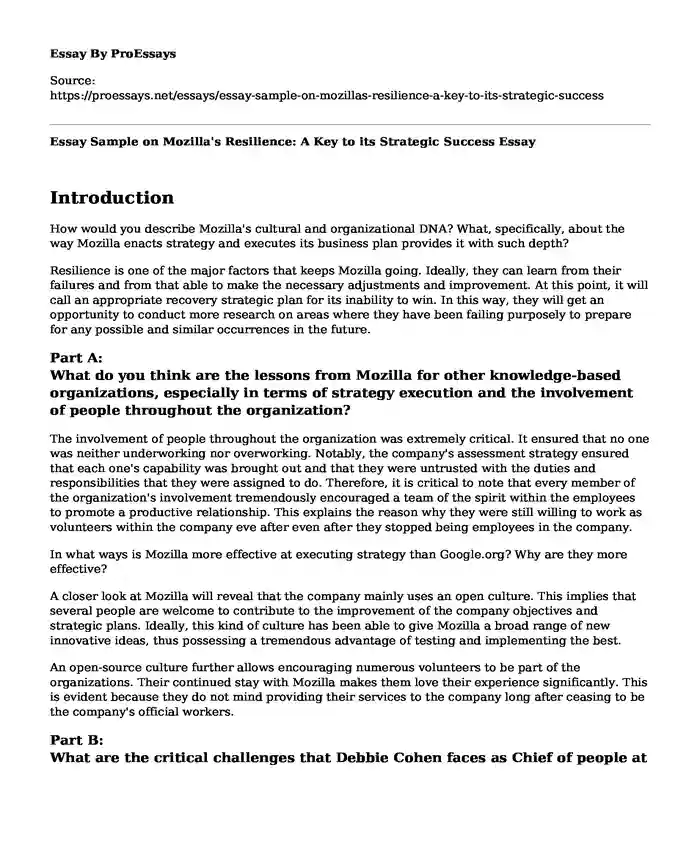Introduction
How would you describe Mozilla's cultural and organizational DNA? What, specifically, about the way Mozilla enacts strategy and executes its business plan provides it with such depth?
Resilience is one of the major factors that keeps Mozilla going. Ideally, they can learn from their failures and from that able to make the necessary adjustments and improvement. At this point, it will call an appropriate recovery strategic plan for its inability to win. In this way, they will get an opportunity to conduct more research on areas where they have been failing purposely to prepare for any possible and similar occurrences in the future.
Part A:
What do you think are the lessons from Mozilla for other knowledge-based organizations, especially in terms of strategy execution and the involvement of people throughout the organization?
The involvement of people throughout the organization was extremely critical. It ensured that no one was neither underworking nor overworking. Notably, the company's assessment strategy ensured that each one's capability was brought out and that they were untrusted with the duties and responsibilities that they were assigned to do. Therefore, it is critical to note that every member of the organization's involvement tremendously encouraged a team of the spirit within the employees to promote a productive relationship. This explains the reason why they were still willing to work as volunteers within the company eve after even after they stopped being employees in the company.
In what ways is Mozilla more effective at executing strategy than Google.org? Why are they more effective?
A closer look at Mozilla will reveal that the company mainly uses an open culture. This implies that several people are welcome to contribute to the improvement of the company objectives and strategic plans. Ideally, this kind of culture has been able to give Mozilla a broad range of new innovative ideas, thus possessing a tremendous advantage of testing and implementing the best.
An open-source culture further allows encouraging numerous volunteers to be part of the organizations. Their continued stay with Mozilla makes them love their experience significantly. This is evident because they do not mind providing their services to the company long after ceasing to be the company's official workers.
Part B:
What are the critical challenges that Debbie Cohen faces as Chief of people at Mozilla, specifically in terms of strategy execution and alignment? What should she do to meet these challenges, and why?
It is undeniable that being Chief of people presents Cohen with lots of numerous challenges. One of the significant issues addressed in this case occurs as a result of asking non-productive volunteers and employees to move on from the organization. Undeniably, it needs considerable courage to face an employee purposely to inform them about their inabilities to make the appropriate contribution towards the vision of the company. Under these circumstances, Cohen requires to provide a comprehensive explanation to such members within the company about her intentions and the manner to achieve this. This decision will ensure that they understand the situation and not feel devalued. Another challenge was being open about individual earnings. This challenge occurs based on the fact that Mozilla being an open culture comprised the wellbeing of both the employees who were being paid and those who were not. Studies have shown that not all people are curious about their earnings being known to others. At the same time, others are always not. In this sense, it is critical to strike a balance between the two, which is quite challenging in this case.
How knowledge and competent practice of cross-functional strategic thinking can help individual stakeholders of the organization and other members outside the organization to participate more fully in organizational efforts to improve long-term performance and overall stakeholders' performance?
In companies where cross-functional thinking is implemented, every employee possesses a specific task that is he or she is entrusted with. This is done to enable them to work towards achieving the existing common goal (Shams et al. 2019). In most cases, the individuals involved include those within and outside the organization. They include the employees and stakeholders, such as suppliers and customers. The significance of this approach is that each individual is aware that the organization's success depends on their contribution, without which such success would dwindle. This is critical in helping every stakeholder feel appreciated and valued and become motivated to work even more. It is essential to note that cross-functional strategic thinking is both cooperative and competitive (Bungay, 2011).
References
Bahrami, Homa. "People operations at Mozilla Corporation: Scaling a global peer-to-peer community." California Management Review 56.1 (2013): 67-88.
https://studydaddy.com/attachment/41626/5t9evnvq46.pdfBungay, S. (2011). How to make the most of your company's strategy. Harvard Business Review, 89(1-2), 132-140.
Shams, S. R., Vrontis, D., Weber, Y., Tsoukatos, E., & Ferraris, A. (Eds.). (2019). Cross-functional knowledge management: The international landscape. Routledge.
Cite this page
Essay Sample on Mozilla's Resilience: A Key to its Strategic Success. (2023, Sep 15). Retrieved from https://proessays.net/essays/essay-sample-on-mozillas-resilience-a-key-to-its-strategic-success
If you are the original author of this essay and no longer wish to have it published on the ProEssays website, please click below to request its removal:
- Wireless Networks Questions Paper Example
- Research Paper Example on Robotics
- Data Warehousing Essay Example
- How Technological and Societal Changes have Augmented Federal Power? - Essay Sample
- Cyber Security Threat Landscape
- Essay Example on Unix Desktop Users: System & Network Administration
- Organization Security: Protecting Database from Risks - Essay Sample







